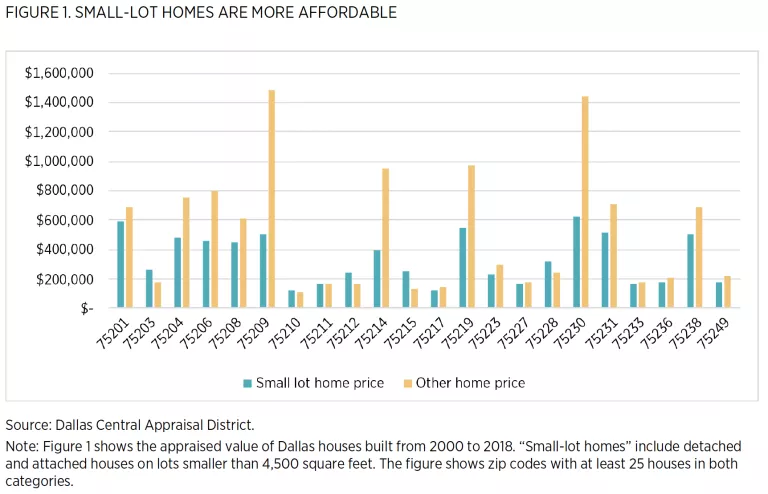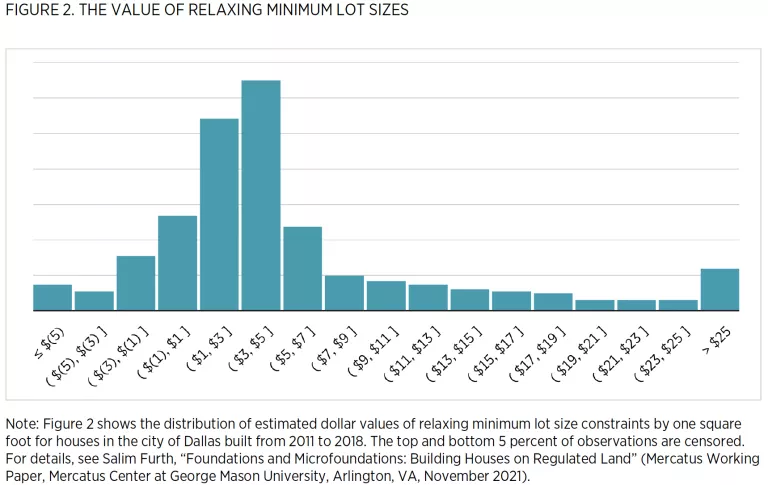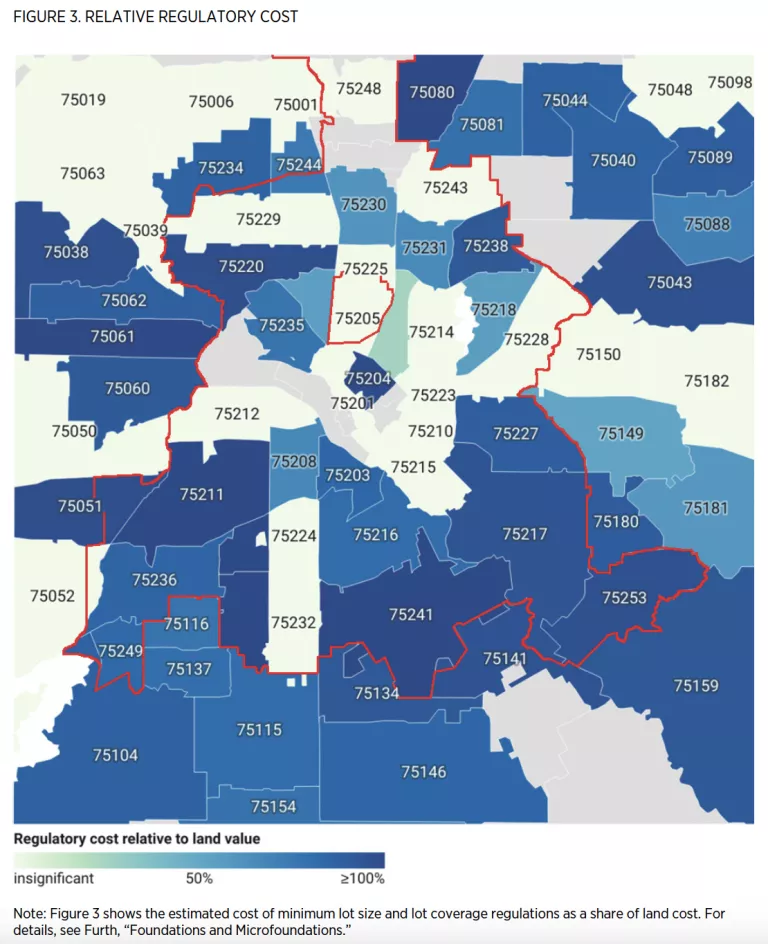- | Housing Housing
- | State Testimonies State Testimonies
- |
Minimum Lot Size Regulations Are a Barrier to Homeownership in Dallas
Mayor Johnson and Council members, thank you for giving me the opportunity to share my research on the issue of minimum lot size regulations in Dallas. I study land-use regulation and housing markets as codirector of the Urbanity Project at the Mercatus Center at George Mason University. The Mercatus Center is proud to be a financial supporter of the North Texas Zoning Atlas, which we hope will be a valuable tool for cities and citizens throughout the region. In my personal capacity, I am an advisor to the board of Texans for Reasonable Solutions.
Minimum lot size regulations are the most universal, and thus most influential, land-use statues in the United States. Lot size regulations impose high costs on both prospective buyers and current homeowners. As you know, the most prevalent minimum lot size in the city of Dallas is 7,500 square feet. The city, however, has a longstanding tradition of “uncoordinated lenience” and has permitted over 4,000 small-lot houses since 2000. [1] It would be more equitable and efficient to replace the existing system with a reformed one of generalized lenience.
In this paper I discuss the following characteristics of these rules:
- Minimum lot size regulations lead to high housing costs for buyers.
- Minimum lot size regulations reduce land value for owners.
- Elimination of lot size controls is a better solution than uncoordinated lenience.
Costs to Buyers
For buyers, the consequence of minimum lot size regulations is that the bottom rung of the housing-cost ladder is much higher than in a housing market regulated only for building safety and public health. Among Dallas houses built since 2000, those on lots under 4,500 square feet cost $388,000 on average in 2019. Houses on larger lots averaged $573,000. As figure 1 shows, the discount tends to be largest in the most expensive zip codes.
In 2019, a popular mortgage calculator estimated that the small-lot home would have been affordable to the 39 percent of Dallas County households earning at least $75,000 per year. [2] The comparable conventional-lot home would have required an income of $108,000 per year, a level achieved by only 23 percent of households.
Dallas-area prices have inflated by 47 percent since 2019, and interest rates today are also much higher. [3] Current prices for the same houses are thus much higher and much less affordable. However, the same principle we saw in 2019 applies today: a substantially larger share of households can afford new homes built on small lots.
The most obvious reason that small-lot houses are cheaper is that their buyers are purchasing less land. But a more consequential reason is that houses built on small lots are 25 percent smaller than those built on conventional lots. Unfortunately, small-lot houses are uncommon, representing just 13 percent of recently built houses.

Cost to Owners
For current landowners, minimum lot size regulation reduces home values by excluding potentially valuable future use. In peer-reviewed research, I found that in 2019 the average cost of minimum lot size requirements in Dallas was $4.25 per square foot, [4] making up more than half the average value for the same land at $7.06 per square foot.
Figure 2 shows the estimated value, in dollars per square foot, of relaxing minimum lot size constraints on Dallas houses built between 2011 and 2018. Figure 3 shows the estimated cost of minimum lot size and lot coverage regulations as a share of land cost across Dallas zip codes.
Many owners, of course, are not planning to sell and are enjoying their neighborhood as it currently exists. How do the costs and benefits of regulation shake out for them? In new research on Houston, economists estimate that cutting minimum lot size requirements from 5,000 to 1,400 square feet benefits the average homeowner by just over $8,000 by raising land value, while the cost of the change due to potential increased density is less than $6,000. [5] One can quibble about the details, but the proof of the pudding is in the votes: only 16 percent of eligible Houston blocks opted out of the minimum lot size reform.


Costs of "Uncoordinated Lenience"
The city of Dallas does not systematically enforce the minimum lot size regulations. Instead, as Alexius Marcano et al. note, “Dallas has 899 [Planned Development Districts], each with its own litany of subordinances and many containing sub-[Planned Developments] within them.” [6] As a result, actual lot sizes frequently depart from their predevelopment minimum lot size.
This discretionary approach to regulation increases staff work, invites corruption, and gives neighbors the impression that developers are cheating the system. It is also inequitable: People with time and sophistication can work the system; others cannot.
Before reforming its minimum lot size in 1998, Houston had a similar practice of uncoordinated lenience. Authors M. Nolan Gray and Adam Millsap show that before the reform Houston granted subdivision permits for small lots mostly in areas that were “largely Hispanic and low income.” [7] After the reform, more permits were issued in higher-income neighborhoods.
It would be a mistake, however, to shut down the discretionary system in Dallas without creating a better option for delivering diverse types of housing at a range of price points. The system has, after all, delivered over 4,000 small-lot houses since 2000. As figure 1 shows, small-lot houses are much more attainable than new houses built on larger lots.
Conclusion
I thank the Council for considering minimum lot size reform and giving me the opportunity to inform its thinking on this important issue. If the evidence presented in this brief and by other witnesses is persuasive, a natural question arises: If 7,500 square feet is not the appropriate lot size, what is? Is it 2,500 as in Austin’s ongoing reform proposal? Or 1,400 as in Houston? Or 900, the smallest recorded lot size currently found in Dallas? The best answer is that lot size is not worth regulating. There are many aspects of the built environment—height, impervious surface, setbacks—that have implications for neighbors. But lot size has no such spillovers. Once we admit that small homes are a feature, not a bug, there is no reason to constrain how builders meet future buyers’ needs.
Notes
Alexius Marcano, Matthew Festa, and Kyle Shelton, “Developing Houston: Land-Use Regulation in the ‘Unzoned City’ and Its Outcomes” (Working Paper, Kinder Institute for Urban Research, Rice University, Houston, TX, 2017), 11.
I assumed that buyers had no debts, deposited 20 percent, and received a 4 percent interest rate, which was common in 2019. See “How Much House Can I Afford?” NerdWallet, https://www.nerdwallet.com/mortgages/how-much-house-cani-afford (accessed 11/21/23). Income data are from the American Community Survey via IPUMS: Steven Ruggles, Sarah Flood, Matthew Sobek, Daniel Backman, Annie Chen, Grace Cooper, Stephanie Richards, Renae Rogers and Megan Schouweiler, IPUMS USA: Version 14.0 (dataset) (Minneapolis, MN: IPUMS, 2023).
Texas A&M University Real Estate Research Center (database), “Home Price Index for Dallas-Fort Worth-Arlington,” 2019Q3 to 2023Q3, accessed November 21, 2023, https://www.recenter.tamu.edu/data/home-priceindex/#!/MSA/Dallas-Fort_W….
Empirical calculations throughout this testimony are drawn from the author’s data-work for a 2021 paper. The data reflect 2019 prices. In the paper, I reported figures for Dallas County; here I repeat those calculations using only records from within the City of Dallas. The differences are small. Salim Furth, “Foundations and Microfoundations: Building Houses on Regulated Land” (Mercatus Working Paper, Mercatus Center at George Mason University, Arlington, VA, November 2021). Another study, using different data and methods but covering roughly the same period, estimated a “zoning tax” of $4.27 per square foot in Dallas. See Joseph Gyourko and Jacob Krimmel, “The Impact of Local Residential Land Use Restrictions on Land Values across and within Single Family Housing Markets,” Journal of Urban Economics 126 (2021).
Gregory Dobbels and Suren Tavakalov, “Not in My Back Yard: The Local Political Economy of Residential Land-Use Regulations” (Working Paper).
Marcano, Festa, and Shelton, “Developing Houston,” 11.
M. Nolan Gray and Adam A. Millsap, “Subdividing the Unzoned City: An Analysis of the Causes and Effects of Houston’s 1998 Subdivision Reform,” Journal of Planning Education and Research 43, no. 4 (2020), 11.

